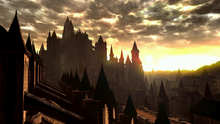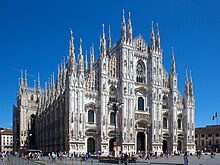Anor Londo
| Anor Londo | |
|---|---|
| Dark Souls location | |
 A view of Anor Londo as seen in Dark Souls | |
| First appearance | Dark Souls (2011) |
| Last appearance | Dark Souls III (2016) |
| Created by | Hidetaka Miyazaki, Masanori Waragai |
| Genre | Action role-playing game |
| In-universe information | |
| Ruler | Gwyn, Lord of Sunlight (Former), Dark Sun Gwyndolin (Dark Souls), Aldrich, Devourer of Gods (Dark Souls III) |
| Location | Lordran |
| Characters | Dark Sun Gwyndolin, Princess Gwynevere, Ornstein and Smough |
Anor Londo is a fictional city in the Dark Souls series of action role-playing games. Appearing in both Dark Souls and Dark Souls III, it is the seat of the power of the gods, deities of the Dark Souls world who used the power of the First Flame to destroy the Everlasting Dragons that once controlled it. By the time of Dark Souls, however, it has become an abandoned lost city, as Lord Gwyn had long since sacrificed himself to rekindle the fading First Flame. Anor Londo has been cited by critics for its design as well as the level's high difficulty, including a section guarded by two powerful archers, and the level's final boss duo, Ornstein and Smough.
Level content
[edit]Dark Souls
[edit]The player character arrives in Anor Londo after completing Sen's Fortress. After dispatching the boss of the area, the Iron Golem, the player is carried over the otherwise sealed-off wall of Anor Londo by a pack of winged demons.[1] As one of the only non-ruined areas of Lordran, Anor Londo stands in contrast to the other levels of the game.[1] Following their arrival, the player must then travel to Gwyn's Keep to obtain the Lordvessel, passing many obstacles.[1] This includes a duo of Silver Knight archers that guard the buttress leading to a side balcony entrance of the Keep. After fighting their way through the Keep itself, the player must face the level's dual bosses, Dragonslayer Ornstein and Executioner Smough, to gain access to Gwynevere, Princess of Sunlight. She awards the player the Lordvessel, allowing the player to warp away from the level.[2]
Both of the characters are fought in a long, rectangular and empty cathedral, with parallel sets of pillars on either side. The player can either attempt to block Smough with the pillars while attacking Ornstein, or attack Smough while dodging Ornstein, a more difficult task when alone. If Ornstein is defeated first, Smough crushes him with his hammer, and gains the power of lightning.[3] If Smough is defeated first, Ornstein suddenly grows to immense size while retaining his former speed. When the second boss is defeated, the player can purchase the armor of that boss, and in Ornstein's case, obtains the Leo Ring.
Dark Souls III
[edit]When the player revisits Anor Londo, it is bathed in moonlight, frozen over, and has fallen to visible levels of decay.[4] Pathways near the central elevator have crumbled, and force the player to explore a different side of the city. Additionally, a new path exists where a former bonfire once stood.[4] The terrain of Lordran has also clearly shifted heavily over time, with large chunks of Anor Londo and its surrounding walls having vanished, and a new palace being visible in the distance.[4] As the player progresses into Lord Gwyn's keep, parts are blocked off by collapse, and the entire location is waterlogged, full of debris, but decorated with new features such as cloth curtains.[4] In the same room where Ornstein and Smough were formerly fought, the player must face Aldrich, Devourer of Gods, in order to obtain his power and return it to Firelink Shrine.
Plot
[edit]Anor Londo was created by Gwyn, ruler of the gods, to consolidate his power after ushering in the Age of Fire.[5] Many centuries later, upon the fading of the First Flame, he was forced to leave the city along with half of his Silver Knight army to rekindle the flame. At the time of Dark Souls, the only remaining deity in Anor Londo is Gwyndolin, who presides over the Darkmoon covenant. He creates the illusion of sunlight, as well as Princess Gwynevere, to compel the Chosen Undead to defeat Gwyn and rekindle the First Flame yet again. If the player attacks Gwynevere, the illusion is shattered and the city reverts to its true appearance, shrouded in darkness.[2]
By the time of Dark Souls III, the city was repopulated and renamed Irithyll[citation needed]. However, it is taken over by a dark sorcerer named Sulyvahn, who enslaved the city's populace and turned them into monstrosities. Sulyvahn would later be allied with Aldrich, Devourer of Gods, a former human cleric who mutated into an amorphous blob due to his cannibalism, and one of the five Lords of Cinder resurrected to link the First Flame. The player finds Aldrich housed within the cathedral of Gwyn's ruined keep, in the process of slowly consuming the very body and soul of the still-living Gwyndolin.
Development
[edit]
Anor Londo was designed to feel like a reward after completing Sen's Fortress, but also presented no clear path to the player, forcing them to take a number of side paths, like walking up the flying buttresses.[6] The city's spiral staircases were meant to represent life.[6]
The city's design was inspired by that of Milan Cathedral, which was visited in person by Dark Souls designer Masanori Waragai.[7] The game's director, Hidetaka Miyazaki, felt that the sense of excitement the player feels upon entry to Anor Londo does not last for the level's entirety.[8]
Reception
[edit]Edge called Anor Londo "as beautiful as it is deadly" and "where Dark Souls casts off restraint". Comparing it to the Divine Comedy, and the strata traversed by Dante in the poem, they equated Anor Londo with Heaven, and that it therefore "makes sense that it's the one area in the game you are incapable of reaching by your own agency".[1] Calling the first glimpses of Anor Londo "dazzling", they state that since Dark Souls is "so bleak at times, so starved of warmth and light", the city's beauty "seems almost eye-shadingly pornographic".[1] Kotaku cited the environmental storytelling of the city's design, where the obvious path forward is blocked, showing the player they do not belong there.[9] Patrick Klepek of Kotaku called the appearance of Anor Londo in Dark Souls III a "highlight" of his playthrough and the city's architecture "beautiful" and "haunting".[10]
Den of Geek called Anor Londo one of "gaming's greatest levels", saying that it "represents the core appeal of Dark Souls", by being designed to "intimidate and impress" the player, as well as being full of mysteries.[2] Cian Maher of The Washington Post called Anor Londo one of the "eight wonders of the virtual world", calling the "gorgeously lit skyline" "striking" in comparison to the darkness of the rest of the game, and stating that "the people - or deities - who inhabit the city also contribute to its sublimity."[11] Eurogamer called revisiting Anor Londo in Dark Souls III a "surreal, melancholy experience" that "ranks among Dark Souls III's many high points", but also "shows how the series line has evolved, both technically and in its visual direction".[4]
Several critics consider the Ornstein and Smough encounter to be one of the most memorable and significant boss fights in video games. IGN's Chiloi Rad calling it the "singularly defining encounter in the whole of the first Dark Souls", and the staff considered it one of the most unforgettable video game moments of all time.[12] Mark Serrels of Kotaku called the fight "perhaps the most notorious boss battle in Dark Souls", and stated that he felt "pure zen" when he beat it, confident that he was going to win after many repeated attempts.[13] Joe Donnelly of PC Gamer called the duo one of the best Dark Souls bosses, and "one of the series' most epic showdowns", adding that "my own inability to topple them keeps me coming back for more".[14] Derek Swinhart of Game Informer noted that Ornstein and Smough "have become referenced far outside of their origins", adding that the fight "remains challenging and incredibly satisfying years later, and even veteran players can't let their guard down".[15]
The Silver Knight archers of Anor Londo were criticized by PC Gamer's Joe Donnelly as the moment he fell out of love with the game, saying that the game never felt unfair until that moment.[16]
References
[edit]- ^ a b c d e "Dark Souls' most famous city is as beautiful as it is deadly". gamesradar. Retrieved 2018-02-21.
- ^ a b c "Dark Souls: Why Anor Londo Is One of Gaming's Greatest Levels". Den of Geek. Archived from the original on 2018-05-25. Retrieved 2018-02-21.
- ^ Mecheri, Damien (2017). Dark Souls: Beyond the Grave. Vol. 1. Romieu, Sylvain. Toulouse: Third Editions. ISBN 978-2-37784-000-7. OCLC 1120769318.
- ^ a b c d e Morgan, Thomas (2016-04-27). "Revealed: Dark Souls 3's special treat for series veterans". Eurogamer. Retrieved 2020-02-21.
- ^ MacDonald, Keza (2016-05-05). "A Guide to Dark Souls' Plot (In Case You Missed It)". Polygon. Retrieved 2018-02-21.
- ^ a b "Dark Souls 1 - Design Works Interview - Souls Lore". soulslore.wikidot.com. Retrieved 2018-02-21.
- ^ Stanton, Rich (2014-03-13). "The Real Dark Souls Starts Here: 13 Real-Life Inspirations for Lordran". IGN. Retrieved 2018-02-21.
- ^ "Dark Souls Creator Hidetaka Miyazaki's Favorite Zones". Game Informer. Archived from the original on September 14, 2015. Retrieved 2018-02-21.
- ^ Dahlen, Chris. "What Dark Souls Is Really All About". Kotaku. Retrieved 2018-02-21.
- ^ Klepek, Patrick. "The Nostalgic Moment In Dark Souls 3 That Made Me Go 'Oh, Shit'". Kotaku. Retrieved 2018-02-21.
- ^ Maher, Cian (2019-06-04). "Perspective | From Ancestor Glade to Hyrule Castle, these are the eight wonders of the virtual world". Washington Post. Retrieved 2020-02-21.
- ^ Rad, Chiloi. "Top 100 Unforgettable Video Game Moments Time". IGN. Archived from the original on September 29, 2021. Retrieved September 29, 2021.
- ^ Serrels, Mark. "Five Emotions You Feel Killing Bloodborne Bosses". Kotaku. Archived from the original on 2018-02-20. Retrieved 2018-02-20.
- ^ Donnelly, Joe (2018-05-25). "The best and worst Dark Souls bosses". PC Gamer. Archived from the original on 2021-03-04. Retrieved 2020-12-08.
- ^ Swinhart, Derek. "The 13 Best Bosses From Bloodborne, Dark Souls, And Demon's Souls". Game Informer. Archived from the original on 2021-05-12. Retrieved 2020-12-09.
- ^ "When was the exact moment you fell out of love with a game?". pcgamer. Retrieved 2018-02-21.
